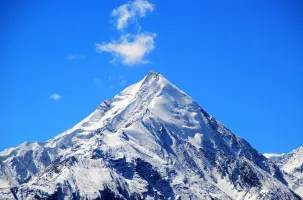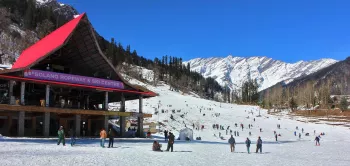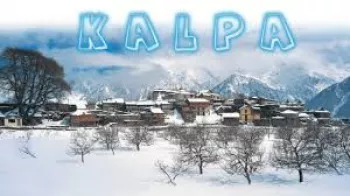Aru Valley
Duration
2 to 4 Days
2 to 4 Days
Best time to visit
May-Aug
May-Aug
Theme
Hill Station, Adventure
Hill Station, Adventure
Aru Valley Travel Guide
Aru Valley, located in the scenic state of Jammu and Kashmir in India, is a picturesque destination nestled amidst lush green meadows and snow-capped mountains. Known for its serene beauty and tranquil environment, Aru Valley offers a perfect retreat for nature lovers and adventure enthusiasts alike. The valley is a gateway to the mesmerizing Kolahoi Glacier and serves as a base camp for treks to Sonamarg and Pahalgam.Top Attractions in Aru Valley
- Scenic meadows and rolling hills
- Kolahoi Glacier trek
- Aru Wildlife Sanctuary
- Baisaran Valley
- Tarsar Lake
Aru Valley is Famous for
Peaceful natural surroundings and thrilling trekking opportunities.Top Attractions in Aru Valley
- Stunning landscapes for photography
- Rich biodiversity in Aru Wildlife Sanctuary
- Adventure activities like camping and trekking
- Local culture and traditional Kashmiri cuisine
What's Great about Travelling to Aru Valley?
- Perfect for nature lovers seeking tranquility
- Great for adventure enthusiasts looking for trekking opportunities
- Ideal for those who appreciate stunning landscapes and photography
What's Not So Great about Travelling Aru Valley?
- Not suitable for travelers looking for a bustling city experience
- May not be ideal for individuals with mobility issues due to rugged terrain
- Limited accommodation options in the valley
Travel Tips for Aru Valley
- Carry sufficient warm clothing, especially if visiting in the winter months
- Respect the local culture and traditions
- Book accommodation in advance due to limited options
Important Aru Valley trip information
- Ideal Duration: 2-3 days
- Best Time to Visit: May to September for pleasant weather
- Nearby Airports and Railway Stations: Srinagar Airport (80 km) and Jammu Tawi Railway Station (290 km)
Per Person
12,000
*EXCLUDING APPLICABLE TAXES 3.7 Ratings
( 5 Reviews )
( 5 Reviews )
Per Person
18,500
*EXCLUDING APPLICABLE TAXES 5.0 Ratings
( 4 Reviews )
( 4 Reviews )
Per Person
13,000
*EXCLUDING APPLICABLE TAXES 5.0 Ratings
( 4 Reviews )
( 4 Reviews )
Per Person
18,500
*EXCLUDING APPLICABLE TAXES 5.0 Ratings
( 4 Reviews )
( 4 Reviews )
Total
69,000
*EXCLUDING APPLICABLE TAXES 5.0 Ratings
( 21 Reviews )
( 21 Reviews )
Per Person
28,000
*EXCLUDING APPLICABLE TAXES 3.7 Ratings
( 5 Reviews )
( 5 Reviews )
FAQ's on Aru Valley
Q1: What is the best time to visit Aru Valley?
The best time to visit Aru Valley is during the summer months from May to September when the weather is pleasant and ideal for outdoor activities like trekking and camping. However, if you want to experience snowfall and winter sports, then the months of December to February are perfect. Avoid the monsoon season from July to August as heavy rainfall can disrupt travel plans.
Q2: Do I need a visa to travel to Aru Valley?
Most tourists traveling to Aru Valley will require a valid Indian visa. However, if you are a citizen of Nepal or Bhutan, you may not need a visa for entry. It is advisable to check the specific visa requirements based on your nationality before planning your trip.
Q3: What are the must-visit attractions in Aru Valley?
Aru Valley is known for its picturesque landscapes and offers attractions like Lidder River, Aru Wildlife Sanctuary, and the scenic Tarsar Lake. Trekking to Kolahoi Glacier and exploring the Betaab Valley are also popular activities. Don't miss the opportunity to witness the local culture by visiting nearby villages like Pahalgam and experiencing the warm hospitality of the locals.
Q4: Is Aru Valley a safe place to travel?
Aru Valley is generally a safe destination for travelers. However, it is advisable to be cautious, especially while trekking or engaging in adventurous activities. Avoid isolated areas at night and always follow local guidelines. It is recommended to travel with a registered guide for outdoor expeditions.
Q5: What is the local currency in Aru Valley and can I use credit cards?
The local currency in Aru Valley is the Indian Rupee (INR). While credit cards are accepted in some hotels and larger establishments, it is advisable to carry cash for smaller purchases and local markets. ATMs are available in nearby towns like Pahalgam for convenient access to cash.
Q6: What is the local cuisine like in Aru Valley?
The cuisine in Aru Valley is influenced by Kashmiri flavors and offers dishes like Rogan Josh, Yakhni, and Dum Aloo. Don't miss trying the traditional Kashmiri Wazwan feast, which includes a variety of meat dishes served with saffron-infused rice. Vegetarian options like Rajma Chawal (kidney beans with rice) are also available. Be sure to taste the local Kahwa tea, a traditional Kashmiri beverage.
Q7: What transportation options are available in Aru Valley?
Transportation options in Aru Valley include taxis, shared jeeps, and buses for getting around the region. It is advisable to hire a local driver for ease of travel, especially when visiting remote areas or trekking trails. Renting a car is also an option for exploring the nearby attractions at your own pace.
Q8: Are there any cultural norms or etiquette I should be aware of when visiting Aru Valley?
When visiting Aru Valley, it is important to respect the local customs and traditions. Dress modestly, especially when visiting religious sites, and remove your shoes before entering a home or temple. It is customary to greet locals with a polite "Salaam" and show courtesy in interactions. Avoid public displays of affection and ask for permission before taking photographs of people. Embrace the warm hospitality of the Kashmiri people and be open to experiencing their rich culture.
Q9: I am a travel agent. How can I buy travel leads of Aru Valley?
Register yourself as a travel agent at agents.tripclap.com and then you can buy travel leads to Aru Valley once your account is approved. For more details contact our support team at +91-8069186564 or support@tripclap.com




